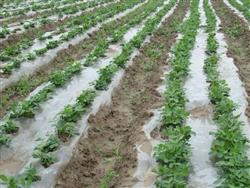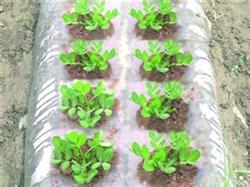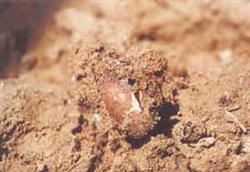Technology of plastic Film mulching in large area of Spring Peanut to increase yield by soil moisture and dry sowing

Fruit sowing covered with plastic film is an effective measure for early sowing, seedling preservation, drought resistance and yield increase of spring peanut. Linmu County Agricultural Technology Extension Center began to experiment and demonstrate since 1987. From 1992 to 1993, the implementation area reached 8520 hectares, and the average yield reached 3982.5 kg/ha and 4057.5 kg/ha, increasing by 13.9% and 16.1%. In the past three years, the promotion area has been about 10,000 hectares, driving the average yield of 18,000 hectares of peanuts in the whole county to break through 4500 kg/hectare for three consecutive years, and a large area of 7500 kg/hectare has emerged. 1. The main yield-increasing mechanism of plastic film mulching for peanut sowing has been tested, demonstrated and popularized in Linmu County for many years. The yield law is: stable yield in rainy years, large yield increase in autumn drought years, and larger yield increase in severe autumn drought years. Generally, the yield of seeds increased by 300 kg/ha ~780 kg/ha, 6.2%~17.4% than that of rice mulching peanut, and 988.5 kg/ha ~1695 kg/ha, 24.0%~49.6% than that of open field peanut. The main mechanisms of yield increase are: 1. Early-sowing with soil moisture, one-sowing whole seedlings. About 18,000 hectares of peanuts are planted all the year round in Linmu County. Spring peanuts account for more than 80% of the total planting area. Most of them are planted on hilly dry land. The suitable sowing time is generally in the middle and late April. This period is often "drought for nine years in ten years", which seriously affects the spring sowing and whole seedlings of peanuts. Because of the double-layer protection of shell and plastic film, fruit-seeded film-covered peanuts can withstand low temperature and not rot seeds. They can be sown early by soil moisture. Generally, they can be sown 10 ~15 days earlier than rice-seeded film-covered peanuts and 25 ~30 days earlier than open-field rice. The sowing date can be advanced to the end of March to the beginning of April. At this time, due to the low temperature, less evaporation of soil moisture, soil moisture is good, conducive to peanut a full seedling, seedling Qi Miao Zhuang. 2. Lodging resistance fruit mulching peanut sowing early, low temperature, the whole growth period performance plant shorter, more branches, short internodes, plant type compact. When the high temperature and high humidity climate comes (mid-late July), peanuts have already entered the fruiting period, and have obvious effects of fruit control, stable growth and lodging resistance. According to the experiment of sowing date in 1989, the height of main stem sown on April 5 was only 27.5 cm, and the height of main stem sown later was more than 30 cm. 3. Early fruiting, high rate of full fruiting. Plastic film mulching can promote the development of peanut reproductive body, flowering early, early fruiting, high rate of full fruiting. According to the experimental investigation, within a certain range, every 5 days of early sowing, effective flowers increased by 2%~3%, fertilization rate increased by 7.5%~9%, full fruit rate increased by 3.8%~7.6%, and the number of fruits per kilogram decreased by 72 ~114. 4. Drought and disaster resistance, high yield and stable production Linmu County climate characteristics "ten spring nine drought, ten autumn eight drought", spring drought seedlings difficult, autumn drought fruit is not full. Fruit sowing plastic film peanut early spring borrow moisture to take the whole seedlings, early fruit, different degrees of staggered autumn drought on the impact of fruit. Because of early sowing, the emergence period can be staggered spring drought, seedlings are complete; early bearing, the fruiting period can be staggered autumn drought, fruit more fruit full, so the more autumn drought years, the greater the yield increase. Since 1989, there has been no autumn drought in 1990 and 1995, and the yield has increased by about 10%. In other autumn drought years, the yield has increased by more than 10%. Among them, the autumn drought in 1989, 1992 and 1994 was serious, and the yield increased by more than 20%. In order to promote the deep development of peanut roots and improve drought resistance, peanut fields are generally deep ploughed in winter or deep ploughed in early spring 30 cm, which is generally more than 20% higher than that of conventional shallow ploughing 15 cm ~20 cm. Fruit sowing covered peanut, early fruiting period, the end of the flood season, the field water easy to rot fruit. Therefore, it is necessary to do a good job in supporting the three ditches, thoroughly cure "half waterlogging" and "waterlogging", and ensure timely drainage after rain. 2. Apply enough base fertilizer, formula fertilization fruit sowing plastic film peanut in the principle of fertilization to master the steady application of nitrogen and phosphorus, increase potassium fertilizer, supplement micro-fertilizer. Generally, on the basis of applying enough organic fertilizer, the average amount of pure nitrogen, phosphorus pentoxide and potassium oxide applied per hectare is 75 kg, 112.5 kg respectively, and the ratio is 1: 1.5: 1.5. The fertilization method is that all potassium fertilizer and 2/3 nitrogen fertilizer are applied early and deeply in cultivated land, and phosphorus fertilizer and 1/3 nitrogen fertilizer are applied in ridging package. Through increasing fertilizer, reasonable proportion, fertility, soil improvement, enhance water storage and fertilizer retention capacity. 3. The practice of selecting improved varieties and treating seeds for many years has proved that the growth period of fruit-seeded film-covered peanuts is long, and the production potential is large when selecting middle-late mature large peanuts; in autumn waterlogging years, the middle-late mature varieties are lighter than the early-maturing varieties, and the buds are less, and the yield increase range is large. Selection of seed fruit is an important technical link in fruit sowing and film mulching. Because fruit sowing is not as good as rice sowing, seed quality can be directly identified. Therefore, before sowing, pods with good color and full seeds should be strictly selected for seed, insects, buds, withered fruits and hidden fruits should be eliminated, and seeds should be dried for 2 ~3 days. Do a good job of seed treatment, the method is: first double kernel fruit open, single kernel fruit pinch opening, and then soak 1 to 2 days, to basically soak the kernel shall prevail. 4. For several years, the sowing time of fruit sowing covered peanut is suitable at the end of March and the beginning of April, 10 ~15 days earlier than rice sowing covered peanut, 22 ~25 days after sowing, and the seedlings are released after the frost. According to the experiment, sowing on April 1, the average pod yield was 5550 kg/ha, which was 310.5 kg/ha and 456 kg/ha higher than that of sowing 5 days and 10 days later respectively. The yield of late sowing 10 days was 429 kg/ha lower than that of rice sowing in the same period. Because of the compact and short plant type, the planting density of fruit-seeded film-covered peanut should be increased appropriately, which is generally about 10% higher than that of conventional rice-seeded peanut. Suppress after sowing to prevent seedling apices from emerging. 5. Control diseases and insects, protect leaves and fruits, cover seeds with 7.5 kg of 10% phoxim per hectare to ensure complete seedlings. In the middle of July, the effect of 40% isofenoxphos methyl 1000 times solution irrigation on white grubs was 95%. From the first ten days of July to the first ten days of August, spraying 40% carbendazim 500 times solution or Yebanjing 600 times solution to control leaf spot disease for 2 ~3 times, the yield increase effect reached 15.4%. At the later stage of peanut growth, timely spray 1% urea and 0.2% potassium dihydrogen phosphate aqueous solution once or twice on the leaves to prolong the functional period of leaves and promote pod fruiting and fullness.
- Prev

Eight points for attention in plastic Film mulching cultivation of Spring Peanut
The application of plastic film mulching cultivation technology in peanut production can play the role of increasing temperature, preserving whole seedlings, preserving water and fertilizer, so as to achieve the purpose of increasing yield, increasing income and striving for seasonal initiative. In 2002, our institute conducted a comparative experiment on spring peanut cultivation with plastic film mulching, and achieved a yield of 402.75 kg per mu and 367 in the field.
- Next

How to prevent the rotten seeds of spring peanuts after sowing
Rotten seeds often occur before emergence of spring peanuts after sowing, and the serious rate of rotten seeds is as high as 20%, resulting in varying degrees of lack of seedlings and broken ridges. Causes of rotten seed: poor seed quality or improper storage, long storage period, low-lying terrain, soil viscosity, poor texture, high soil water content, long seedling emergence time, unsolid soil preparation, affecting species.
Related
- The first cup of black tea in spring, the flavor and history of tea gardens in Kenya, Africa
- The computer can not only choose potatoes, but also grow tea rice. AI will grow winter oolong tea champion.
- It is not only the inflated tea bitten by insects, but also engraved with the four seasons tea in Beipu.
- The Oriental Beauty Tea Festival in Zhuxian County takes the stage at the weekend to experience the plus-size feast of oil tea.
- & quot; Oriental Beauty Tea & Exploration of Emei in Hsinchu, the hometown of quot;
- The new variety of strawberry "Tainong 1" dessert is the first choice with mellow aroma. Crimson gorgeous
- History of Tea in Taiwan: from Wild Inner Mountain to Export Tea Garden
- Two types of Taiwan Oriental Beauty Black Tea won the British three-Star Award for Childhood Tea Xiang Zhang Jiaqi changed from pilot to champion tea maker.
- Banana species and varieties: the planting history of Taiwan Xianren banana and dwarf banana is long, is banana disease resistant?
- Coffee planting Technology: Qianjie Coffee from Seedling to harvesting

